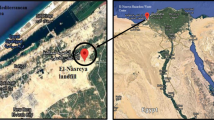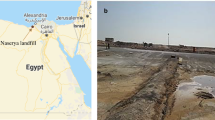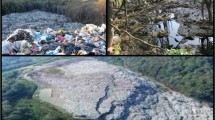Abstract
Industrial activities annually produce millions of tons of hazardous waste which are disposed eventually on landfills. In this study, the effect of saline industrial hazardous landfill leachate (SIHLL) contamination on the engineering properties of natural and contaminated silty clay soil was investigated in a laboratory program to assess the potentials of using this soil as a barrier for the lining of the saline hazardous industrial waste landfill. The contaminated specimens were prepared by mixing the natural soil with SIHLL at different concentrations (0, 25, 50, 75, and 100%). The results revealed that the permeability coefficient (K) and total pore volume of soil contaminated with SIHLL decreased as the SIHLL concentration increased from 0 to 50%. This was mainly due to the presence of high concentration of salts in SIHLL. The angle of internal friction (φ) of SIHLL-contaminated soil dropped from 24.95° (for 0% SIHLL) to 20.24° for 100% SIHLL, whereas this was not the case for the cohesion (C), where the value increased from 1.161 t/m2 for 0% SIHLL to 3.705 t/m2 for 100% SIHLL. A considerable decrease in consistency limits was observed for the contaminated soil at different SIHLL concentrations. Based on these findings, the studied silty clay soil can be feasible for construction of new hazardous solid waste landfill liner thanks to its low permeability and widespread availability in Egypt. The study recommends to carefully line the landfill with fully impervious liner materials to protect the soil and the groundwater from the leachate hazards.
Access provided by Autonomous University of Puebla. Download conference paper PDF
Similar content being viewed by others
Keywords
1 Introduction
Rapid population growth and industrial expansion are the biggest challenges facing many developing countries, as massive amounts of municipal and industrial solid waste have been annually generated. The situation urges proper management of such waste and alternatives have to be found because disposing of the solid waste in traditional ways such as incineration or open dumping poses health and environmental threats [1].
Clay soil plays a crucial role in the lining of waste barriers, possessing low permeability which assists in minimizing the migration of hazardous leachate into the environment. Such barriers are in the form of slurry walls, landfill liners and covers, and lagoon liners [2]. However, the infiltration of hazardous leachate through the soil would cause groundwater contamination and changes in the geotechnical properties of the soil. Once those barriers have been significantly damaged, the toxic leachate can be dispersed by rainfall to the groundwater, and therefore it might be extended to the surrounding areas [3].
To appropriately evaluate the performance of the clay liner that can be used as a barrier in the landfill site, its behavior in real landfill leachate must be investigated. The effect of municipal landfill leachate on the geotechnical properties of soil has been extensively investigated in previous studies, whereas less attention has been paid to the impact of hazardous industrial landfill leachate on those properties [4]. The primary objective of this study, hence, is to systematically investigate the effect of SIHLL on the geotechnical characteristics of silty clay soil with emphasis on the permeability, Atterberg limits, and shear strength of leachate-contaminated soil as compared to the natural one.
2 Materials and Methods
The SIHLL used in this study was harvested from Al-Nasreya landfill (35 km southwest of Alexandria, Egypt) which receives industrial wastes. The fresh SIHLL was transported to the laboratory in sealed plastic barrels and directly used. The SIHLL is an alkaline liquid with pH of 8.78, electrical conductivity of 61 dS/m, and total dissolved solids of 38,990 mg/L. Some hydrocarbons and sulfur compounds were detected in the leachate from gas chromatographic-mass spectrometer (such as sulfurous acid, propane, hexadecane, oxalic acid, and 1,2-bezene dicarboxylic acid). Five distinct concentrations of SIHLL were used in this study: 0% (i.e., distilled water), 25% (i.e., 1 SIHLL to 3 distilled water by volume), 50% (i.e., 1 SIHLL to 1 distilled water by volume), 75% (i.e., 3 SIHLL to 1 distilled water by volume), and 100% (i.e., raw SIHLL).
The soil was collected from borrow pits cited in Borg Al-Arab city, Alexandria at a depth of 2.5 m. The engineering properties of the natural soil are listed in Table 1. According to previous studies, the minimum plasticity index (PI) required for a clay liner is to be greater than 15 [5] or 10 [6] while its liquid limit (LL) required should be greater than 30% [5]. The laboratory permeability coefficient (K) of compacted clay liner must be less than 1.0 × 10–7 cm/s [7]. Therefore, the studied soil satisfies the requirement of the plasticity index, liquid limit, and permeability values.
The soil samples were dried in the oven at a temperature of 105° C for 24 h, followed by pulverization using a plastic hammer. All tests were performed according to ASTM Standards.
3 Results and Discussion
The coefficient of permeability (K) and total pore volume of natural and contaminated soil are presented in Fig. 1. The K value of contaminated soil with 25% SIHLL concentration decreased from 8.6 × 10–8 (for the natural samples) to 5.86 × 10–8 cm/s; however, its value with 50% SIHLL remained at the same level of 5.91 × 10–8 cm/s. The decrease in the K value is mainly because the total pore volumes of natural soil decreased from 10.24 × 10–2 to 7.65 × 10–2 cm3/g at increasing SIHLL concentrations from 0 to 50%, respectively. The permeability and pore volumes are likely decreased due to the presence of high salts in the SIHLL. Nevertheless, further increasing of SIHLL concentration, in this study, has led to increase the K and total pore volume.
The shear strength parameters (φ and C) of the natural and contaminated soil are indicated in Fig. 2. The φ of the contaminated soil with 100% of SIHLL dropped from 24.95° (for natural soil) to 20.54°. This is likely due to the coating of the soil particles with hydrocarbons compounds which were detected in the SIHLL, resulting in a reduction of internal friction. The alkaline SIHLL, in addition, led the soil particles to be finer with such dissolution reaction of the substrate being possibly important in the alternation of internal friction.
Even though the friction angles of soil were reduced by SIHLL supplementation, their cohesions significantly increased as presented in Fig. 2. This increase in cohesion could be associated with the increase of the internal forces between soil particles due to the presence of ions and other components in the SIHLL. The contaminated soil pores are filled with quite high suspended solids in the leachate.
The effect of SIHLL concentrations on the consistency limits (PL, LL, and PI) of natural and contaminated soil is presented in Fig. 3. A considerable decrease in PL was observed in contaminated soil at different SIHLL concentrations. Similar trends were observed for LL of the contaminated soil with increasing the SIHLL concentrations from 0 to 100%. The reduction in consistency limits of the soil could be attributed to the reduction in the surface area of soil particles resulting in low absorption of water that changes the liquid limit and plastic limit values. Our results from Brunauer, Emmett, and Teller Method (BET) test revealed that the surface areas of the contaminated soil with 100% declined from 47.21 to 28.91 m2/g.
4 Conclusions
This study investigated the effects of saline hazardous landfill leachate (SIHLL) on the alternation of engineering properties of Egyptian silty clay soil via laboratory-based experiments. The plasticity index of natural soil was dropped in SIHLL-contaminated samples. This could be attributed to the reduction of diffused double layer thickness surrounding the clay particles. The friction angle of the contaminated soil with 100% of SIHLL dropped from 24.95° (for the natural soil) to 20.54° due to coating the soil particles with hydrocarbons’ compounds which were detected in the SIHLL. Based on the measurements of the permeability of soil and the methods used to assess the effectiveness of clay liner, the studied silty clay soil seemed to be suited for constructing a new hazardous solid waste landfill liner due to its availability in Egypt. Based on the results of this study, landfill leachate should be carefully lined with impervious liner materials and tested for zero leakage before using to ensure high protection for the soil and the groundwater against the leachate hazards.
References
Environmental Quality International (EQI): Alternative Methods for Solid Waste Management and Treatment and Disposal of Wastewater: Report No. 7. United States Agency for International Development (USAID)/Egypt (2005)
Moavenian, M.H., Yasrobi, S.S.: Volume change behavior of compacted clay due to organic liquids as permeant. Appl. Clay Sci. 39(1–2), 60–71 (2008)
Ratnaweera, P., Meegoda, J.N.: Shear strength and stress-strain behavior of contaminated soils. Geotech. Test. J. 29(2), 1–8 (2006)
Khodary, S.M., Negm, A.M., Tawfik, A.: Geotechnical properties of the soils contaminated with oils, landfill leachate, and fertilizers. Arab. J. Geosci. 11(13), 1–13 (2018)
Gordon, M., Huebner, P.: An evaluation of the performance of four clay lined landfills in Wisconsin. In: The Seventh Annual Waste Conference, Wisconsin, pp. 399–469 (1990)
Danie, D.E., Benson, C.H.: Water content density criteria for compacted soil liners. J. Geotech. Eng. 116(12), 1811–1830 (1990)
McBride, J.F., Horton, R., Thompson, M.L.: Evaluation of three Iowa soil materials as liners for hazardous-waste landfills. In: Proceedings of the Iowa Academy of Science, vol. 94, pp. 73–77 (1987)
Acknowledgements
The first author would like to thank the Egyptian Ministry of Higher Education (MoHE) for providing her the financial support (Ph.D. scholarship) for this research as well as the Egypt-Japan University of Science and Technology (E-JUST) and the Soil Mechanics and Foundation Laboratory, Faculty of Engineering, Alexandria University for offering the facilities and tools needed to conduct this research.
Author information
Authors and Affiliations
Corresponding author
Editor information
Editors and Affiliations
Rights and permissions
Copyright information
© 2021 The Editor(s) (if applicable) and The Author(s), under exclusive license to Springer Nature Switzerland AG
About this paper
Cite this paper
Khodary, S., Fath, H., Negm, A., Tawfik, A. (2021). Measuring the Engineering Properties of Landfill Leachate-Contaminated Soil. In: Ksibi, M., et al. Recent Advances in Environmental Science from the Euro-Mediterranean and Surrounding Regions (2nd Edition). EMCEI 2019. Environmental Science and Engineering(). Springer, Cham. https://doi.org/10.1007/978-3-030-51210-1_203
Download citation
DOI: https://doi.org/10.1007/978-3-030-51210-1_203
Published:
Publisher Name: Springer, Cham
Print ISBN: 978-3-030-51209-5
Online ISBN: 978-3-030-51210-1
eBook Packages: Earth and Environmental ScienceEarth and Environmental Science (R0)







